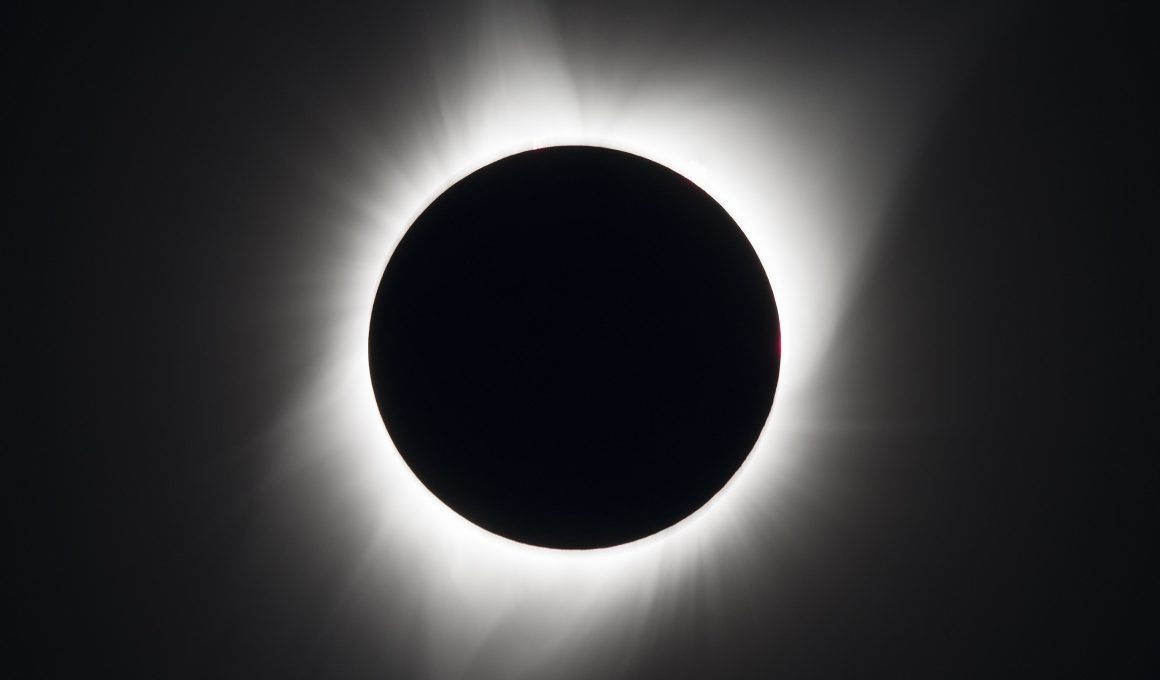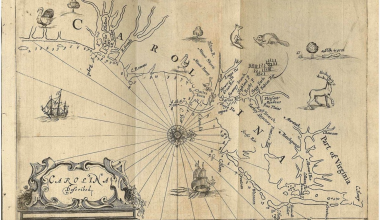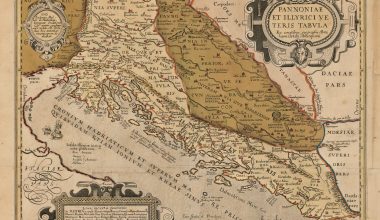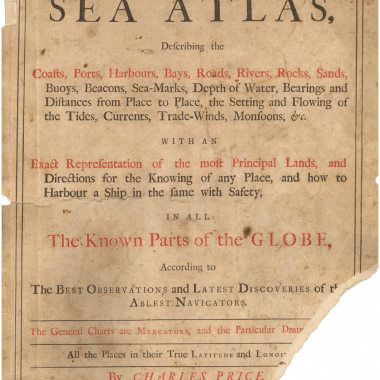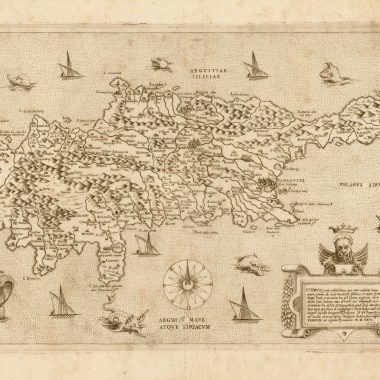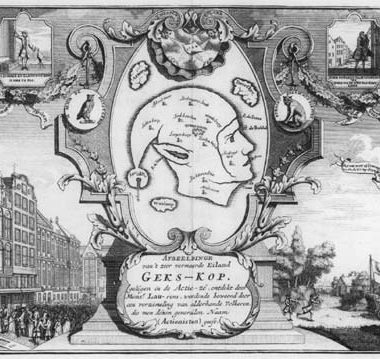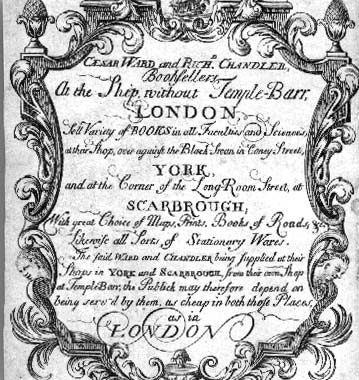Transcribed from the Universal Magazine for July 1755.
A Description of a Piece of Mechanism contrived by James Ferguson, for exhibiting the Time, Duration, and Quantity of Solar Eclipses, in all Places of the Earth. Illustrated with a Copper-plate.
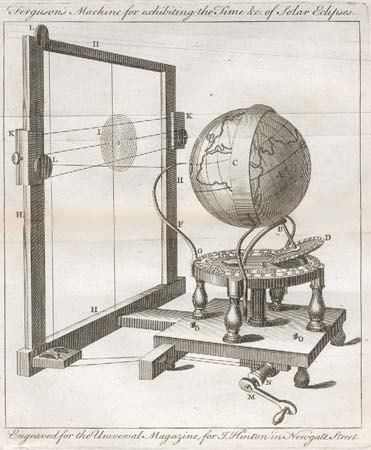
The principal parts of this machine (see the copper-plate) are:
1. A terrestrial globe turned round, by a handle on an axis inclined 23½ degrees. On this axis is an index, which goes round a dial-plate of 24 hours in each rotation of the globe.
2. A circular plate, on whose limb are inserted the months and days of the year. This plate supports the globe, and, by turning it till any given day comes to a fixed pointer called the annual index, gives the axis of the globe the same position to the sun, or to a candle properly placed, that the earth’s axis has to the sun on that day of the year.
3. A penumbra, or thin circular piece of brass, divided into twelve digits by concentric circles, which represent a section of the moon’s penumbra, and is proportioned to the size of the globe; so that the shadow of this plate, formed by the sun, or a candle placed an a convenient distance, with its rays transmitted through a convex lens, to make them parallel on the plate, covers exactly all those places on the globe, which the moon’s penumbra do on the earth. So that any solar eclipse may be shown with this machine, by candle-light, almost as well as by the light of the sun.
4. A frame, on the two upright sides of which are scales of the moon’s latitude, or declination from the ecliptic. To these scales are fitted two sliders, with indices for adjusting the penumbra’s center to the moon’s latitude, as it is north or south, ascending or descending.
5. A crooked wire, which always points to the middle of the earth’s enlightened disk.
6. A solar horizon, dividing the enlightened from the darkened hemisphere of the globe, and shewing at what places the general eclipse begins, as at the greatest obscuration, or ends, with the rising or setting sun.
7. A handle, which, by wheel-work, turns the globe round its axis, and at the same time, by a thread and pullies, carries the penumbra over its surface with a velocity proportional to that of the moon’s shadow over the earth; which, being quicker or slower, according to the different distances of the moon from the earth, is easily regulated, in the machine, by changing one of the pullies.

To rectify the machine for use
The true time of new moon, and her latitude at that time, must be first known. If her latitude exceeds the number of minutes on the scales, there can be no eclipse of the sun at that conjunction; but, if it does not, the sun will be eclipsed to some places of the earth: And, to shew the times and various appearances of these eclipses, at those places, proceed in order, as follows:
If you rectify for performing by the light of the sun;
1. Move the sliders till their indices point to the moon’s latitude on the scales, as it is at that time north or south, ascending or descending.
2. Turn the month-plate till the day of new moon comes to the annual index.
3. Unscrew the collar on the axis of the handle, and set the penumbra, by hand, till its center comes to the perpendicular thread in the middle of the frame.
4. Turn the handle till the meridian of London, on the globe, comes just under the point of the crooked wire; stop there, and turn the hour-circle, by hand, till XII. at noon comes to the index.
5. Turn the handle till the hour-index on its circle points to the time of the new moon, and, holding it there, screw fast the collar on its axis. Lastly, elevate the machine till the sun shines through the sight-holes on its pedestal; and the whole will be rectified.
To rectify for shewing by candle-light, proceed, in every respect, as above, save in the last article; instead of which, place a candle before the machine, about four yards from it, so as the shadow of the intersection of the threads, in the middle of the frame, may fall precisely on that part of the globe, to which the crooked wire points: Then, with a pair of compasses, take the distance betwixt the penumbra’s center and intersection of the threads, and equal to that distance set the candle higher or lower, as the penumbra’s center is above or below the said intersection. Lastly, Hold a convex lens betwixt the penumbra and candle, so as the candle may be in its focus.
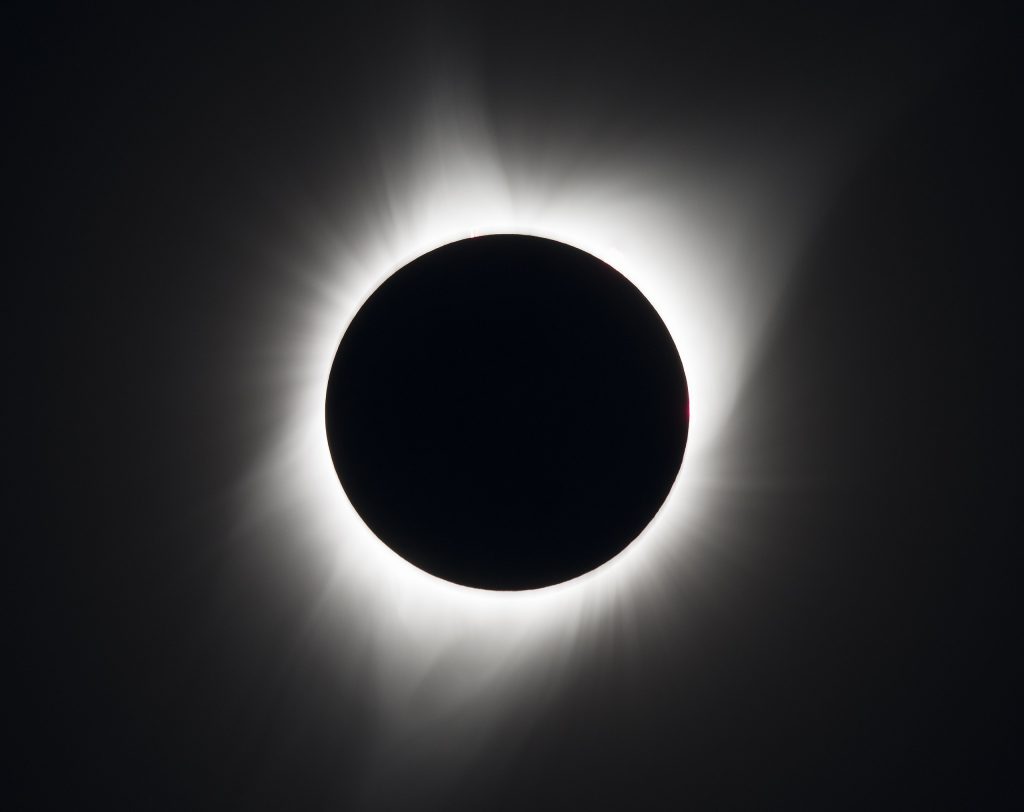
These things done, which may be as soon as expressed, turn the handle backward until the penumbra almost touches the right side of the frame; then turn it gradually forward, and observe the following phænomena:
1. Where the eastern edge of the shadow of the brass penumbra first touches the globe at the solar horizon, those, who inhabit the corresponding part of the earth, see the eclipse begin on the uppermost edge of the sun just at the time of rising.
2. In that place where the center of the penumbra first touches the globe, the inhabitants have the sun rising upon them centrally eclipsed.
3. When the whole penumbra just falls upon the globe, its western edge at the solar horizon touches and leaves the place, where the eclipse is ending on the lowermost edge of the sun at its rising.
Continue turning, and, 4. The cross lines in the center of the penumbra will go over all those places of the globe, where the sun is centrally eclipsed.
5. When the eastern edge of the shadow touches any place of the globe, the eclipse begins there: When the vertical line in the penumbra comes to any place, then is the greatest obscuration at that place; and, when the western edge of the penumbra leaves the place, the eclipse there ends; the times of all which are shewn by the index on the hour-circle: And, from the beginning to the end, the shadows of the concentric circles shew the number of digits eclipsed at all the intermediate times.
6. When the eastern edge of the penumbra leaves the globe under the solar horizon, the inhabitants see the sun beginning to be eclipsed on his lowermost at his setting.
7. Where the penumbra’s center leaves the globe, the inhabitants see the sun set centrally eclipsed. And, lastly, where the penumbra is wholly departing from the globe, the inhabitants see the eclipse ending on the uppermost part of the sun’s edge at the time of its disappearing in the horizon.
References to the figure of the machine.
A, the terrestrial globe.
B, its axis.
C, the solar horizon.
D, the hour-circle, with its index.
E, the month-plate.
F, the crooked wire.
G, the annual index.
H, H, H, H, the square frame, the scales being on the sides hid from view taken in the drawing.
I, the penumbra.
K, K, the sliders.
L, L, L, pullies, over which the line runs, that moves the penumbra.
M, the handle to which both ends of the line are fixed.
N, a collar on the axis of the handle.
O,O, the sights on the pedestal.
